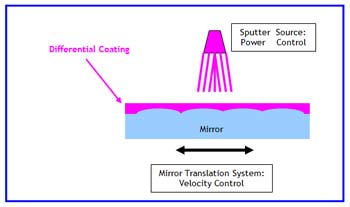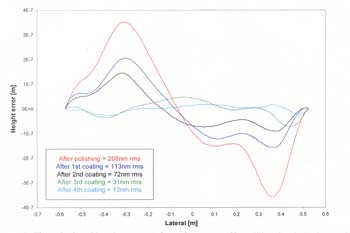Research and Development
Profile Coatings for Nanometer Slope Error X-ray Mirrors
X-ray mirrors of the kind manufactured by Crystal Scientific are primarily used at synchrotron radiation sources to deliver focussed beams of x-rays to a wide range of experiments into basic research, materials and life sciences. The tolerances on the shape and surface finish of x-ray mirrors, especially large mirrors (>1m in length), are very exacting, and new experiments at the latest generation of synchrotron radiation sources are pushing the boundaries of what can be achieved.
As the limits of conventional polishing technology are reached, it becomes necessary to consider other methods for improving the mirror slope error. Our approach is that of differential coating, in which the slope errors are corrected by selectively depositing material onto the mirror surface by using a magnetron sputtering technique – effectively "filling in" the low points on the surface.
The science of magnetron deposition (or sputtering) is very well known in many industries, and is already used to provide high atomic number uniform thickness coatings to x-ray mirrors. A differential coating process has been used by one synchrotron optics group (APS, Chicago) to produce improvements in the figure of a short mirror (<100mm long). Crystal Scientific have been developing a system to apply the differential coating process to long mirrors, >1m. This involves cycles of deposition and characterisation with the NOM to iteratively reduce the slope and figure errors of the mirror.
Experiments on a 1.2m mirror showed that after four cycles the slope error was reduced from 1.624µrad to 0.441µrad rms. The clearest validation of the deposition process is shown in the graph on the left which shows the reduction in height error from 208nm to 13nm rms.
The development of this technique is discussed in the paper "A preferential coating technique for fabricating large, high quality optics" by S.G. Alcock and S. Cockerton. Click here to access the full paper.



